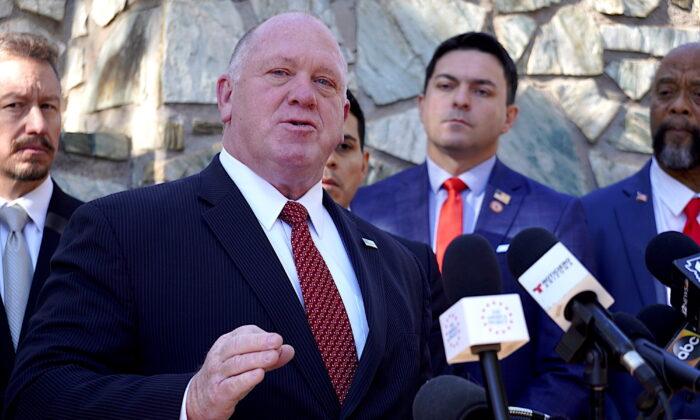Commentary
Roughly 90 percent of fentanyl deaths in the United States can be traced back to China, with Mexican drug cartels turning Chinese precursor materials into finished products. However, the Chinese Communist Party (CCP) is doing nothing to stop the sale of Chinese chemicals to the cartels.
“At the very top of this lethal food chain are bad actors in China manufacturing fentanyl and the CCP who is allowing their lethal fentanyl engine to run while it kills off thousands of Americans,” read a March 1 statement by Rep. Dan Newhouse (R-Wash.), a member of the United States House Select Committee on Strategic Competition between the United States and the Chinese Communist Party. Newhouse said that fentanyl is part of the pattern of aggression from the CCP and an existential threat to the United States.
More than 100,000 Americans died of drug overdoses last year. While claims that fentanyl is the leading cause of death among people aged 18 to 45 may be exaggerations, the majority of opioid deaths are indeed within this age group. Fentanyl is 50 to 100 times more powerful than other opioids, with only 2 milligrams comprising a lethal dose. Additionally, not only is fentanyl more addictive, but it is also cheaper to manufacture. The high potency makes it easier to smuggle, making it a huge moneymaker for transnational drug-trafficking organizations. In Aug. 2022, Customs and Border Protection officers seized a single shipment weighing 187 pounds that was worth an estimated $4.3 million.

A display of the fentanyl and meth seized by U.S. Customs and Border Protection officers at the Nogales Port of Entry is pictured during a press conference in Nogales, Ariz., on Jan. 31, 2019. Mamta Popat/Arizona Daily Star via AP
Most of the fentanyl that enters the United States comes through the southern border. Mexican cartels use precursor chemicals from China to manufacture the drug, which is then smuggled into the United States. Many congressional representatives blame President Biden’s open border policies for the problem, which make it easier for drugs and gang members to enter the country. In addition to strengthening U.S. border protection, authorities recognize the need to cooperate with foreign countries. Mexico, however, has proved to be an unreliable partner in stopping the tide of narcotics. Police, military, and politicians there are either accepting payoffs or have been intimidated into cooperating with the cartels—or both.
China has been similarly unhelpful. In 2019, after pressure from U.S. authorities, the CCP agreed to classify “all fentanyl-related substances” as controlled substances. The CCP issued a statement in 2022 expressing their concern for the “safety and well-being of all mankind.”
The statement claimed that “China has been providing sufficient, comprehensive, and selfless assistance in this regard to the countries concerned.”
But like so many of Beijing’s promises, the words remain just words. And China continues to be the number-one source of fentanyl precursor chemicals. As a result, about 90 percent of all fentanyl in the United States can be linked to China.
Assistant Secretary of State for the Bureau of International Narcotics and Law Enforcement Affairs, Todd D. Robinson, told the Senate Foreign Relations Committee on Feb. 15 that, while the CCP has effectively outlawed the sale of fentanyl and similar products, they have not done enough to stop the continued sale of chemicals. According to Robinson’s testimony (pdf), “The PRC can and must do more to act meaningfully in this regard beyond its class-wide control of fentanyl-related substances.”
In addition to profiting from the sale of fentanyl precursor chemicals, Chinese entities earn additional profits by helping the cartels launder their ill-gotten gains. As China is making money on both ends, and the Mexican government is in the middle doing almost nothing, lawmakers are proposing legislation to hold foreign governments accountable. Sen. John Thune (R-S.D.) introduced the Justice Against Sponsors of Illicit Fentanyl Act (pdf) in February, which mirrors the Justice Against Sponsors of Terrorism Act. The bill removes some of the immunity afforded foreign governments that aid in fentanyl trafficking, and allows victims and their families to sue Mexico and China for damages.
While fentanyl is killing Americans in record numbers, a new threat has been identified by the Justice Department’s Drug Enforcement Administration (DEA): an animal sedative called xylazine (pdf) which goes by the street name of “tranq.” It is often mixed with fentanyl, thus dramatically increasing the risk of overdose death. At a cost of only $6 to $20 per kilogram, tranq multiplies the potential profits to the Mexican cartels.
Like fentanyl, the cartels are sourcing tranq from China.
The CCP claims that there is no large-scale fentanyl abuse problem in China. Given the fact that the state security apparatus there can monitor nearly every aspect of the lives of every citizen, it seems almost certain that the CCP is aware that Chinese firms are selling these chemicals—and that they are allowing them to be shipped out of the country.
Views expressed in this article are opinions of the author and do not necessarily reflect the views of The Epoch Times.





